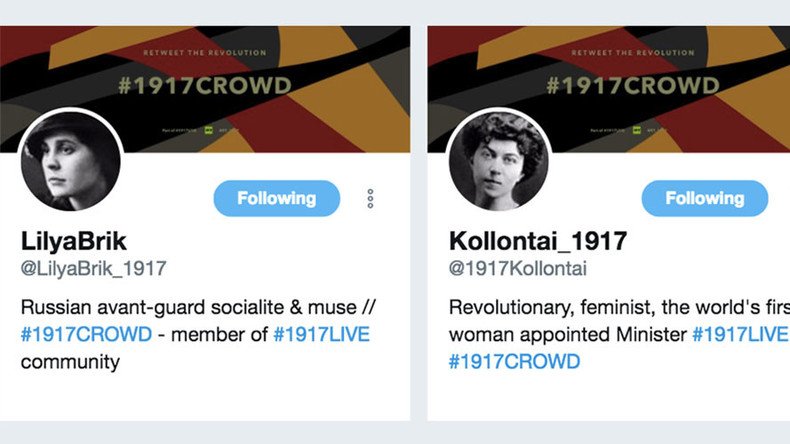‘Free love, gender equality, social equality’: Notable Russians of #1917CROWD, who were they?

RT’s interactive social media project #1917LIVE continues to revive the era’s most enigmatic and prominent figures, and as the circle grows, we highlight some of the Twitter accounts telling the stories of real people from the past whose opinions linger on.
Lilya Brik
Femme fatale, witty girl – in 1917, socialite Lilya Brik was only 25. She is best known as poet Mayakovsky’s muse and lover, but there was much more to her than that.
Smart and well-educated, she herself wrote, edited, acted, and most importantly – inspired. There are numerous paintings of her by famous artists of the time. A photo made by Alexander Rodchenko that was later turned into a collage is still widely used in pop culture.
Turning 26 this November... Me by #Rodchenko#1917LIVE#1917CROWDpic.twitter.com/oqsbMtQxNa
— LilyaBrik (@LilyaBrik_1917) June 6, 2017
During the time of the revolution and in the early 20s, Lilya, her husband Osip Brik, and Mayakovsky were in a sort of love triangle.
With my husband Osip and @Maiakovski_1917#1917CROWDpic.twitter.com/IzupTuZscR
— LilyaBrik (@LilyaBrik_1917) July 7, 2017
Her private diaries are still undisclosed, but some information is out there, suggesting that she led a free-spirited life, didn’t keep her lovers a secret, and believed that true art required freedom.
Alexandra Kollontai
While Lilya Brik had no interest whatsoever in politics, another prominent woman of the time, Alexandra Kollontai, was Vladimir Lenin’s close aid and made history for becoming the first woman to become a minister and one of the first women to become an ambassador (to Sweden).
By 1917, Kollontai was 45 years old, madly in love with revolutionary Pavel Dybenko, 17 years her junior, and at the very core of the Bolshevik movement.
"We are young while we are loved" - about my relationship with revolutionary Dibenko, 17 years younger than me #1917LIVEpic.twitter.com/vNf2CjLr7A
— Kollontai_1917 (@1917Kollontai) June 22, 2017
A brilliant orator, she spoke French, English, German, and Finnish, and used her skills travelling the world with socialist speeches appealing to the working class.
Kollontai herself was from no humble upbringing, however. Born in a general’s family in St. Petersburg, she would later do her best to downplay her wealthy past, calling family estates “country houses,” etc.
If there is no equality between men & women, there is no communism #feminism#equality#1917LIVEpic.twitter.com/U04bizkPNR
— Kollontai_1917 (@1917Kollontai) June 1, 2017
Part of her political career was always devoted to women’s rights and gender equality, based on the notion that socialism brings equality across classes; it should also provide equal rights for women.
Alexander Kolchak
While Kollontai was head over heels in endless love affairs and big international politics, and Lilya Brik was center stage of the avant-garde movement, Naval Commander (later, Admiral) Alexander Kolchak, spent 1917 traveling.
He would say Minister of War Alexander Kerensky practically forced him out of the country against his own will: to England, the United States, Singapore, and China – that was his 1917.
There was an article about me today, and the person who wrote it claimed that I could, in the future, become the leader of Russia #1917LIVE
— Alexander V. Kolchak (@Kolchak_1917) July 5, 2017
In 1918, Kolchak will lead the White Army against the Bolshevik Red Army in Russia’s crippling Civil War, becoming the Supreme Ruler and Commander-in-Chief of All Russian Land and Sea Forces until 1920.
Join #1917LIVE and become part of the crowd
It's easy to join the action, just follow these step-by-step instructions:
READ MORE: #1917LIVE: Be part of revolution on Twitter & write your own history with #1917CROWD hashtag












